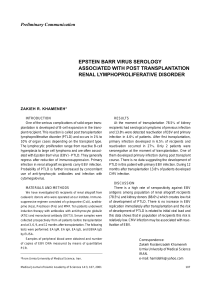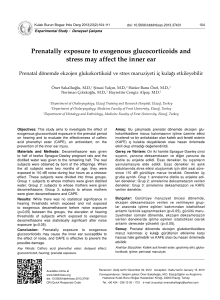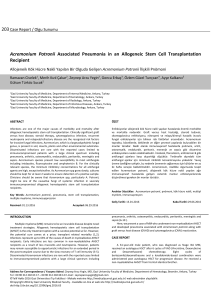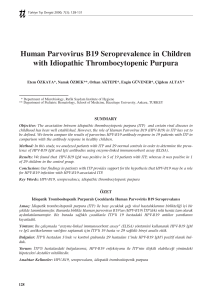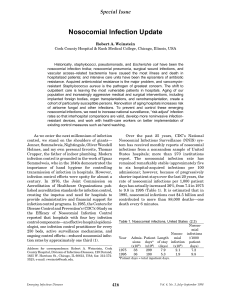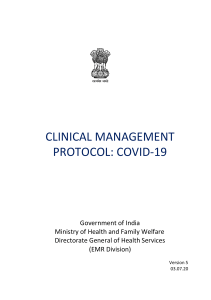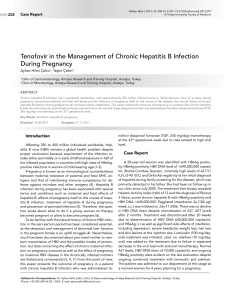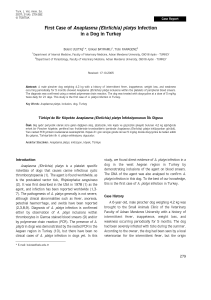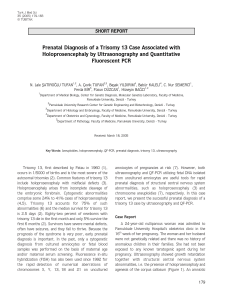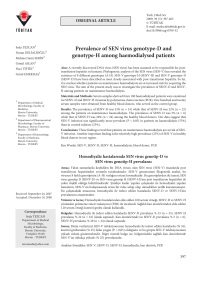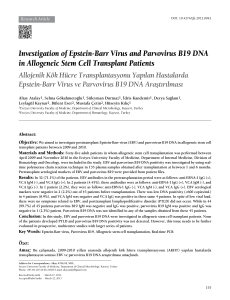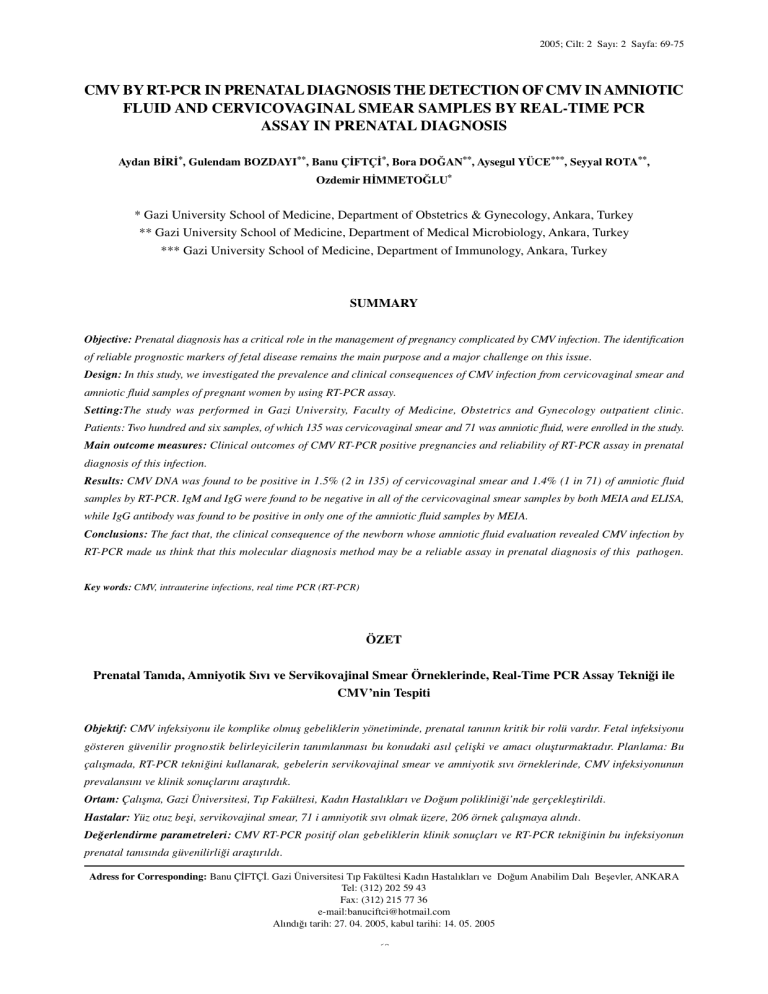
2005; Cilt: 2 Sayı: 2 Sayfa: 69-75
CMV BY RT-PCR IN PRENATAL DIAGNOSIS THE DETECTION OF CMV IN AMNIOTIC
FLUID AND CERVICOVAGINAL SMEAR SAMPLES BY REAL-TIME PCR
ASSAY IN PRENATAL DIAGNOSIS
Aydan BR*, Gulendam BOZDAYI**, Banu ÇFTÇ*, Bora DOAN**, Aysegul YÜCE***, Seyyal ROTA**,
Ozdemir HMMETOLU*
* Gazi University School of Medicine, Department of Obstetrics & Gynecology, Ankara, Turkey
** Gazi University School of Medicine, Department of Medical Microbiology, Ankara, Turkey
*** Gazi University School of Medicine, Department of Immunology, Ankara, Turkey
SUMMARY
Objective: Prenatal diagnosis has a critical role in the management of pregnancy complicated by CMV infection. The identification
of reliable prognostic markers of fetal disease remains the main purpose and a major challenge on this issue.
Design: In this study, we investigated the prevalence and clinical consequences of CMV infection from cervicovaginal smear and
amniotic fluid samples of pregnant women by using RT-PCR assay.
Setting:The study was performed in Gazi University, Faculty of Medicine, Obstetrics and Gynecology outpatient clinic.
Patients: Two hundred and six samples, of which 135 was cervicovaginal smear and 71 was amniotic fluid, were enrolled in the study.
Main outcome measures: Clinical outcomes of CMV RT-PCR positive pregnancies and reliability of RT-PCR assay in prenatal
diagnosis of this infection.
Results: CMV DNA was found to be positive in 1.5% (2 in 135) of cervicovaginal smear and 1.4% (1 in 71) of amniotic fluid
samples by RT-PCR. IgM and IgG were found to be negative in all of the cervicovaginal smear samples by both MEIA and ELISA,
while IgG antibody was found to be positive in only one of the amniotic fluid samples by MEIA.
Conclusions: The fact that, the clinical consequence of the newborn whose amniotic fluid evaluation revealed CMV infection by
RT-PCR made us think that this molecular diagnosis method may be a reliable assay in prenatal diagnosis of this pathogen.
Key words: CMV, intrauterine infections, real time PCR (RT-PCR)
ÖZET
Prenatal Tanıda, Amniyotik Sıvı ve Servikovajinal Smear Örneklerinde, Real-Time PCR Assay Teknii ile
CMV’nin Tespiti
Objektif: CMV infeksiyonu ile komplike olmu gebeliklerin yönetiminde, prenatal tanının kritik bir rolü vardır. Fetal infeksiyonu
gösteren güvenilir prognostik belirleyicilerin tanımlanması bu konudaki asıl çeliki ve amacı oluturmaktadır. Planlama: Bu
çalımada, RT-PCR tekniini kullanarak, gebelerin servikovajinal smear ve amniyotik sıvı örneklerinde, CMV infeksiyonunun
prevalansını ve klinik sonuçlarını aratırdık.
Ortam: Çalıma, Gazi Üniversitesi, Tıp Fakültesi, Kadın Hastalıkları ve Doum poliklinii’nde gerçekletirildi.
Hastalar: Yüz otuz bei, servikovajinal smear, 71 i amniyotik sıvı olmak üzere, 206 örnek çalımaya alındı.
Deerlendirme parametreleri: CMV RT-PCR positif olan gebeliklerin klinik sonuçları ve RT-PCR tekniinin bu infeksiyonun
prenatal tanısında güvenilirlii aratırıldı.
Adress for Corresponding: Banu ÇFTÇ. Gazi Üniversitesi Tıp Fakültesi Kadın Hastalıkları ve Doum Anabilim Dalı Beevler, ANKARA
Tel: (312) 202 59 43
Fax: (312) 215 77 36
e-mail:[email protected]
Alındıı tarih: 27. 04. 2005, kabul tarihi: 14. 05. 2005
69
Aydan Biri ve ark
Sonuç: CMV DNA, RT-PCR teknii kullanılarak, servikovajinal smear örneklerinin %1.5 (2\135) ve amniyotik sıvı örneklerinin
%1.4 (1\71) inde pozitif bulundu. Hem MEIA hem de ELISA, yöntemiyle, IgM and IgG tüm servikovajinal smear örneklerinde
negatif bulundu. Amniyotik sıvı örneklerinin ise sadece birinde IgG pozitif bulundu.
Yorum: RT-PCR teknii ile amniyotik sıvısında CMV infeksiyonu pozitif bulunan yenidoanın klinik sonuçları, bize, bu moleküler
metodun, patojenin prenatal tanısında güvenilir bir teknik olabileceini düündürdü.
Anahtar kelimeler: CMV, intrauterin infeksiyon, real time PCR (RT-PCR)
BACKGROUND
to detect messenger RNA of specific CMV proteins(12).
Human cytomegalovirus (CMV), a member of the
The objective of the present study is the diagnosis and
quantification of CMV DNA, together with investiga-
herpes virus family is the most common cause of
intrauterine viral infection and sensory neural deafness,
tion of the congenital CMV infection in the CMV
positive cases. Additionally, correlation of the amniotic
affecting 0.2–2% of live births (1). Unlike most viral
infections, CMV may be transmitted to the fetus during
fluid and cervicovaginal smear CMV results with
sonographic findings has been evaluated.
either primary infection or reactivation(2). Following
primary infection, the virus is transmitted to the fetus
in approximately 40% of cases (21–68%) (3, 4, 5, 6, 7,
In case of recurrent infection, fetal infection is
MATERIAL AND METHODS
rare (2%)(2). Ten percent of infected fetuses are
symptomatic at birth, consisting mainly of central
Samples
Two hundred and six pregnant women were included
nervous system and multiple organ involvement; 1/3
of them may die and most survivors suffer serious
in the study and 135 cervicovaginal smear and 71
amniotic fluid samples were studied. The cervicovaginal
neurological and systemic sequels(9 and 1) . The
remaining 90% of infected fetuses are asymptomatic,
smear samples were obtained from asymptomatic
women with no history of any accompanying diseases
but 10–15% will develop sequels within the first year
of life, including progressive deafness, visual
to the pregnancy, in their first antenatal visit. Amniotic
fluid samples were achieved from cases by amniocen-
impairment, learning disability, and delayed development(10). In the absence of specific antiviral therapy
tesis that had advanced maternal age (22 cases) or
positive second trimester screening test results (28
or a vaccine which could be safely administered to the
pregnant women with primary human cytomegalovirus
cases). Additionally in 21 cases amniocentesis was
performed because of abnormal USG findings;
infection, prenatal diagnosis has a critical role in the
management of pregnancy complicated by this virus.
oligohydramnios (4 cases); intrauterine growth
restriction (IUGR) (3 cases); both IUGR and
Prenatal diagnosis may be performed for several
reasons: routine prenatal screening; recent maternal
oligohydramnios (3 cases); ventriculomegaly (4 cases);
bilateral choroid plexus cysts greater than 7mm (1
exposure to an infectious pathogen; maternal symptoms
of infection or abnormal sonographic findings (e.g.
case); both echogenic bowel and choroid plexus cyst
(1 case); polyhydramnios (2 cases); omphalocele (1
ventriculomegaly or intracranial calcifications)(11). A
combination of tests, including serology, avidity, and
case); multiple structural abnormalities (1 case), and
hydrops fetalis (1 case). CMV DNA was detected in
polymerase chain reaction (PCR), may be necessary
to improve accuracy of the diagnosis. The interval
these 71 amniotic fluid samples and was found to be
positive in one case by Real Time Polymerase Chain
between exposure to an infectious agent and prenatal
testing can be critical to the interpretation of the test
Reaction assay (RT-PCR) of which viral load was
1.309 105 copy/ml.
result. Available methods used to detect CMV include,
culture, shell vial assays, antigenemia assays (which
Cervicovaginal smear samples were transported in
phosphated buffer saline (PBS) solution and amniotic
quantify positively stained blood leukocytes), PCR to
detect and quantify CMV DNA, and more recently,
fluid samples were taken and transported in sterile
syringes. The samples, which were transported to the
nucleic acid sequence-based amplification techniques
laboratory, were liquated and while the samples, which
and 8).
70
Cmv by rt-pcr in prenatal diagnosis the detectin of cmv in amniotic fluid and cervicovaginal
are to be studied, were taken to study, the others were
samples was studied with MEIA system and its
stored at –80 Co until they were studied.
Real Time Polymerase Chain Reaction (RT-PCR)
appropriate anti CMV IgG kit (Axsym System, Abbott
Laboratories, Abbott Park, ILL,USA).
DNA extraction: 200_l of cervicovaginal smear or
amniotic fluid was used to extract DNA of CMV by
CMV IgG avidity test: The amniotic fluid sample with
positive anti-CMV IgG and the cervicovaginal smear
using High Pure Viral Nucleic Acid Kit (Roche
diagnostics Germany) according to the manufacturer’s
sample with 4U/ml of anti-CMV IgG were studied
with a commercial diagnostic CMV IgG avidity EIA
instructions.
Amplification of DNA by RT-PCR and Quantification:
(Enzyme immunoassay) kit (Radim SPA, PomeziaRome, Italy) according to the manufacturer’s
Metis Biotechnology (Ankara, Turkey), projected
quantitative CMV primers and probe. By using primer
instructions.
premier 5.0 software from pp65 gene (gene bank locus
HSPPBC region) (primer 1:5’ –ATATCGAAA
RESULTS
AAGAAGAGCGC, primer 2 : 5’ – GGTAACCT
GTTGATGAACG , probe: 5’ – FAMGGGATCGT
RT-PCR: One (1/71) of the amniotic fluid samples
ACTGACGCAGTTCCACTAMRA 3’). The presence
of PCR products was detected by an increase in
(1,309 x 105 copy/ml) and two (2/135) of the
cervicovaginal smear samples (corresponding to 2,937
fluorescence signal in Light-Cycler System (Roche
Diagnostic, Germany) 3_l of extracted DNA, 10pmol
x 101 and 2,124 x 102 copy/ml viral loads) were found
to be positive in favor of CMV.
from each primer, 4pmol of probe, 4,5mM of MgCl
and 1 unit Taq DNA polymerase and 1X Reaction
Serology
Hybridization mix from Light-Cycler Master
Hybridization Probe Kit (Roche Diagnostics, Germany)
Anti CMV IgM results: Anti CMV IgM was found to
be negative in all of the amniotic fluid and
were used in Real time PCR reactions. Amplification
was carried out in capillary tubes containing 10 _l total
cervicovaginal smear samples.
Anti CMV IgG results: In all of the samples studied,
reaction volume in stages of incubation at 95 Co for
10 minutes following 45 cycles of 95 Co for 10 second
one amniotic fluid was found to be anti CMV IgG
positive (96 U/ml) and one cervicovaginal smear sample
and 60 Co for 10 second. In each study, HCMV AD
169 DNA containing 2 x 102 – 2 x 106 CMV DNA
was found to be 4U/ml, with negative result. Anti CMV
IgG and IgM results were 0 U/ml in the other samples.
copy with four serial dilutions was used and quantitative
results were analyzed by using Light-Cycler software
Because both tests for anti CMV IgM, and CMV IgG
were designed for only serum evaluation, the cut off
version 3.5.3. A capillary tube containing distilled
water instead of DNA was used a negative control in
values for amniotic fluid and smear may be lower than
the cut off values (10 U/ml) accepted for serum. In
each study. The determining limit was established as
200 CMV DNA / ml in blood.
this respect, the cervicovaginal smear sample with 4
U/ml of anti CMV IgG value was also approved as
Serology
positive and studied with CMV IgG avidity test.
CMV Ig G Avidity test results: According to the kit
Anti-CMV IgM antibody: Specific IgM responding to
CMV in amniotic fluid and cervicovaginal smear
that we used, we considered the values below 35% as
a low avidity, values between 35% - 45% as a gray
samples was studied with two different methods:
microparticle enzyme immunoassay (MEIA) system
zone and above 45% as a high avidity. Low avidity is
a finding in favor of a primary acute infection. The
and its appropriate anti-CMV IgM kit (Imx System,
Abbott Laboratories, Abbott Park, ILL,USA) and a
amniotic fluid sample with positive anti-CMV IgG
was studied with CMV IgG avidity test to evaluate a
commercial diagnostic anti-CMV IgM enzyme-linked
immunosorbant assay (ELISA) kit (Radim SPA,
primary acute infection and, low avidity (25%) was
found. This finding was in favor of a primary acute
Pomezia-Rome, Italy).
Anti-CMV IgG antibody: Specific IgG responding to
infection.
The cervicovaginal smear sample with 4 U/ml of anti-
CMV in amniotic fluid and cervicovaginal smear
CMV IgG value was also studied with CMV IgG
71
Aydan Biri ve ark
avidity test and again low avidity (21%) was found.
an accurate means of quantifying viral DNA; with the
This situation was also suggested a primary acute
infection and supported the hypothesis that anti-CMV
major advantage of avoiding post-PCR handling that
can be the source of DNA carryover(29) . However,
IgG cut off limit could be lower than serum in these
kind of samples.
PCR sensitivity is still sub-optimal, ranging between
71% and 100% and resulting occasionally in falsenegative results in amniotic fluid(3, 4, 5, 6, 7, 21, 23, 26,
and 29).
DISCUSSION
Three major variables were suggested to cause the
false-negative PCR results: gestational age at the time
Although, CMV screening during pregnancy has been
greatly discussed for many years, there has been no
of amniocentesis, elapsed time between maternal
infection and amniotic fluid sampling, and the intrinsic
consensus on this issue yet. If the mother seroconverts
during pregnancy and no maternal or fetal clinical
sensitivity of the PCR protocol used for diagnosis.
Sampling of amniotic fluid before 21 weeks of gestation
manifestations are seen, the fetal management will be
difficult to predict, as its outcome is unknown. Several
and less than 6–9 weeks following maternal infection
was associated with low PCR sensitivity(5, 6, 19, 20, and
factors such as gestational age at the time of maternal
CMV infection, the level of viral replication in both
29). All
mother and fetus, possible differences in viral virulence
and the immune response might influence the outcome
time is not sufficient to explain all misdiagnosed cases
using PCR. Amniotic fluid supernatant is inhibitory to
of fetal infection(13, and 14). Most of these newborns
will never develop any type of complication. Moreover,
PCR, which was proposed as one of the factors to
reduce the intrinsic sensitivity of this assay. In addition,
if any sequel occurs, there has been no specific treatment
to reduce its incidence or severity yet. We should also,
PCR diagnosis of congenital CMV fetal infection is
currently carried out in clinical laboratories by a wide
state that, routine testing would lead to unnecessary
therapeutic abortion.
range of PCR protocols, mostly, non-standardized
assays. There are two PCR-based approaches, which
Prenatal diagnosis of fetal CMV infection is important
for informed decision-making regarding pregnancy
are commonly used for clinical diagnosis: the first is
the nested technique, which includes two amplification
management and for planning of strategies for followup of newborns at risk. Transmission is not affected
stages, of single-round PCR followed by semi-nested
or nested PCR, and the second is the probe hybridization
by the stage of pregnancy(10, 15, and 16). However, some
authors reported an increased rate of transmission with
based technique, which includes single-round PCR
amplification, followed by probe hybridization. Of
increased gestational age(17, and 18). Bodeus et al.
reported transmission rates of respectively 36, 45 and
these two, the latter is standardized, non-labor-intensive,
and allows minimal opportunity for contamination,
77% for the first, second, and third trimester(18).
Viral isolation from amniotic fluid by shell-vial assays
thereby making it the preferred method for diagnosis.
We used RT-PCR techniques; Real time PCR is the
or conventional cell cultures, although reliable indicators
of fetal infection with 100% specificity and positive
first choice method allowing as to evaluate the
quantative measurements of viral load and to follow
predictive value(1, 4, 6, 8, 19, 20, 21, 22, 23, 24, 25, 26, and
27), has low sensitivity and can lead to misdiagnosis
up the treatment efficacy. The association of viral load
of CMV and the rate of affected fetus was well
in up to 50% of cases(19, 20, 23, 25, and 26). PCR detection
of viral DNA in amniotic fluid can detect the presence
documented previously(29) . Therefore, we used realtime PCR method to determine the viral load of CMV
of viral DNA in 7–50% of culture negative amniotic
fluid samples(6, 8, 21, 23, and 26). Viral isolation, the
to evaluate the patients if the intrauterine infections
may cause on fetal anomaly.
classic method for diagnosing congenital CMV
infection, presents technical limitations to its large-
The only positive amniotic sample for CMV PCR had
been obtained from a pregnant woman presented in
scale use. PCR assays provide some advantages, being
particularly fast and practical techniques, as well as
the 23rd week’s gestation. Her ultrasound examination
revealed intrauterine growth restriction and severe
allowing the use of stored samples(28). RT-PCR provides
oligohydramnios. Estimated fetal weight was less than
our amniotic samples were taken before this
gestational age (16-18 weeks); nevertheless, sampling
72
Cmv by rt-pcr in prenatal diagnosis the detectin of cmv in amniotic fluid and cervicovaginal
5 percentile. There were no abnormalities in the
infected via cervical or hematogenous way. In the
chromosomal evaluation of the amniotic fluid, but high
viral load (1,309 x 105 copy/ml) was found with RT-
studies done about this subject, a sexual transport of
CMV infection is shown in sexually active women(34,
PCR. Therefore, CMV infection was thought to be a
reason of intrauterine growth restriction. Detection of
35, and 36).
virus in the amniotic fluid does not necessarily correlate
with symptomatic congenital infection(21). The challen-
CMV(34). There are some studies supporting this idea
about CMV secretion from cervix in young non-
ge is to determine the clinical consequences of fetal
infection. In a study performed by Revello et al(30) .
pregnant women(35, and 37). It is demonstrated that
CMV secretion from cervix increases during pregnancy
although there was no statistical difference between
symptomatic and asymptomatic babies of CMV DNA
(35%)(37, and 38). In comparison with lung, liver kidney
and blood vessels (15% positive) CMV DNA level in
(+) mothers in amniotic fluid with RT-PCR, CMV viral
load was found to be higher in amniotic fluid of the
uterine tissue and cervical smear was found to be higher
(50%)(39). These findings show that, CMV replicates
mothers of symptomatic babies. Guerra et al (21)
indicated that CMV DNA viral load higher than 105
continuously and is secreted from cervix in sexually
active women. As a result, all these data show that,
copy/ml in amniotic fluid could give information about
symptomatic infection. Gouarin et al(29) also detected
CMV infection spreads to placenta and then to embryo
or fetus before spreading to uterine tissues(34).
a higher CMV viral load in symptomatic cases than in
asymptomatic ones in amniotic fluid. Our results seem
In the 135 smear samples included in our study, two
of them were found to be positive with RT-PCR with
to be parallel to those of all authors.
Two week after diagnosis, the fetal death occurred, in
a quantification of 2,937x101 and 2,124x102 copy/ml.
Both of these quantification results seem to be very
25th week. In ELISA studies from amniotic fluid, antiCMV IgG was positive and IgM was negative. CMV
low. However, a possible viral spread to these babies
during delivery and a sexual transport to partners must
IgM in amniotic fluid demonstrates fetal IgM because
IgM isotype antibodies cannot be transported from
be taken into consideration. There were no clinical
findings and no abnormalities on USG examinations
mother by placental way. In this case, amniotic fluid
was investigated with CMV IgG avidity test and, low
in these pregnant women. Both cases delivered healthy
neonates at term, one with vaginal delivery, the other
avidity was found. In the maternal serum both antiCMV IgM, and IgG were positive and IgG avidity was
with cesarean section due to an obstetrical reason. No
clinical or laboratory abnormalities have been observed
low. The help of these findings established primary
acute CMV infection in mother and fetus. Nevertheless,
in newborns and CMV DNA could not to be detected
in the urine samples of these newborns by RT-PCR.
the virus had to be demonstrated in fetal and placental
tissues in order to mention an absolute fetal infection.
ELISA was studied for both of these pregnant women
in cervicovaginal smear samples. While anti-CMV
We also found CMV DNA positivity in fetal and
placental tissues. This finding confirmed primary acute
IgM was found to be negative in both of the smear
samples, CMV IgG was 4 U/ml in the first smear
CMV infection. All these results, with combination of
clinical and laboratory findings made us think that the
sample and non-detectable in the second one. Both test
systems studying anti-CMV IgM and IgG were designed
cause of the fetal death was primary acute infection of
the mother and fetus.
for serum evaluation and probably, the cut off values
for cervicovaginal smear may be lower than the value
It is indicated that virus spread is frequent in pregnant
women with asymptomatic infection and virus can be
considered for serum. In this respect, the smear sample
with 4U/ml of anti- CMV IgG was accepted to be
isolated from 2-28% of pregnant women in cervical
mucus and urine(28) . Latent CMV infection has an
positive and CMV IgG avidity test was performed for
this sample and avidity was found to be low (21%).
affinity to cervical and renal cells(31, and 32). Probably
because of this latency and transient humoral and
This situation was compatible with primary acute CMV
infection and supported the hypothesis that anti-CMV
cellular immunity, suppression during pregnancy and
hormonal changes cervical CMV secretion increases
IgG cut off limit of these kinds of samples could be
lower than serum limit. We should also state that CMV
(33) .
IgG avidity testing is currently the most widely used
Virus can spread from cervix to uterus
ascendantly in primary or reactivated infections of
It is demonstrated that uterine tissues can be
73
Aydan Biri ve ark
2001;97:443–
technique for differentiating between primary and past
CMV infection(4).
4.
Bodeus M, Hubinont C, Bernard P, Bouckaer A, Thomas K,
However recently, to distinguish between CMV primary
Goubau P. Prenatal diagnosis of human cytomegalovirus by
or past infection, an enzyme immunoassay (EIA) test
was developed to assess the IgG response to the CMV
culture and polymerase chain reaction: 98 pregnancies leading
to congenital infection. Prenat Diagn 1999;19:314–7.
Germany)(40).
5.
glycoprotein B (Biotest, Dreieich,
Despite the fact that CMV is isolated as the most
Enders G, Bader U, Lindemann L, Schlasta G, Daiminger A.
Prenatal diagnosis of congenital cytomegalovirus infection in
189 pregnancies with known outcome. Prenat Diagn 2001;21:
frequent causative agent in congenital infections and
despite the augmentation of CMV carriage in cervix
362–77.
6.
during pregnancy, we found CMV DNA positivity in
only two of 135 cases (1.5%). This may be a
Liesnard C, Donner C, Brancart F, Gosselin F, Delforge ML, Rodesch F. Prenatal diagnosis of congenital cytomegalovirus
infection: prospective study of 237 pregnancies at risk. Obstet
characteristic of our pregnant group. Nevertheless,
since the results are lower than the ones studied before,
Gynecol 2000;95:881–8.
7.
they are not fitting to our main goal such as detecting
CMV DNA in cervical smears by RT-PCR and
Lipitz S, Yagel S, Shalev E, Achiron R, Mashiach S, Schiff
E. Prenatal diagnosis of fetal primary cytomegalovirus infection.
Obstet Gynecol 1999;89:763–7.
comparing with anti-CMV IgM and IgG results.
Low viral load and CMV DNA positivity were found
8.
Revello MG, Baldanti F, Furione M, Sarasini A, Percivalle
in only two cases, and maternal or fetal complications
did not occur. Besides, in only one of these cases anti-
E, Zavzttoni M, Gerna G. Polymerase chain reaction for prenatal
CMV IgG positivity was found. Since we cannot say
that demonstration of CMV DNA with RT-PCR in
Med Virol 1995;47:462–6.
diagnosis of congenital human cytomegalovirus infection. J
9.
Jones CA, Isaacs D. Predicting the outcome of symptomatic
congenital cytomegalovirus infection. J Pediat Child Health
cervix is more sensitive than serology with limited
data in this case, advanced studies are needed for more
1995;31:70–1.
10.
accurate predictions.
To demonstrate CMV existence in smear with RT-PCR
Stagno S, Whitley RJ. Herpesvirus infections of pregnancy.
Part I. Cytomegalovirus and Epstein-Barr virus infections. N
Engl J Med 1985;14:1270–4.
guides us to make a decision about type of delivery,
since it has a risk of newborn infection by ascendant
11.
Andrews JI, Diekema DJ, Yankowitz J. Prenatal testing for
spread. In addition, a low avidity in CMV IgG avidity
test may be an important sign for perinatal outcomes.
infectious disease. Clin Lab Med 2003; 23:295–315. Clinical
While the advances in immunologic, sonographic and
molecular biological techniques have improved the
for clinically relevant congenital infections (such as CMV,
clinicians’ ability to diagnose both maternal and fetal
infections, the clinicians’ knowledge of the usefulness
and T. gondii) are reviewed.
manifestations, sonographic findings, diagnosis and treatment
parvovirus B19, varicella-zoster virus, Herpes simplex virus
12.
Revello MG, Lilleri D, Zavattoni M, et al. Prenatal diagnosis
and limitations of these tests is essential to avoid
unnecessary maternal anxiety and to prevent potentially
of congenital human cytomegalovirus infection in amniotic
adverse obstetric interventions.
Microbiol 2003; 41:1772–1774.
fluid by nucleic acid sequencebased amplification assay. J Clin
13.
Barbi M, Binda S, Carappo V, Primache V, Dido P, Guidotti
P. CMV gB genotypes and outcome of vertical transmission:
study on dried blood spots of congenitally infected babies. J
REFERENCES
Clin Virol 2001;21:75-9.
1.
2.
14.
Stagno S. Cytomegalovirus. In: Remington JS, Klein JO, editors.
Infectious diseases of the fetus and newborn infant. Philadelphia:
cytomegalovirus infection: diagnostic and prognostic significance
Saunders; 1995. p. 312–53.
of the detection of specific immunoglobulin M antibodies in
Boppana SB, Rivera LB, Fowler KB, et al. Intrauterine transmission
cord serum. Pediatrics 1982;69:544-49.
15.
of cytomegalovirus to infants of women with preconceptional
3.
Griffiths PD, Stagno S, Pass RF, Smith RJ,Alford CA. Congenital
Garcia AG, Fonseca EF, Marques RL, Lobato YY. Placental
immunity. N Engl J Med 2001; 344:1366–1371.
morphology in cytomegalovirus infection. Placenta 1989; 10
Azam A-Z, Vial Y, Fawer C-L, Zufferey J, Hohlfeld P. Prenatal
(1):1–18.
16.
diagnosis of congenital cytomegalovirus infection. Obstet Gynecol
74
GroseC,WeinerCP. Prenatal diagnosis ofcongenital cytomegalovirus
Cmv by rt-pcr in prenatal diagnosis the detectin of cmv in amniotic fluid and cervicovaginal
29.
infection: two decades later. Am J Obstet Gynecol 1990;163(2):
17.
447–50.
KerosLetal. Real-TimePCRquantification ofhuman cytomegalovirus
Griffiths PD, Baboonian C. A prospective study of primary
DNA in amniotic fluid samples from mothers with primary
cytomegalovirus infection during pregnancy: final report. Br
infection. J Clin Microbiol 2002;40(5):1767-72.
30.
J Obstet Gynaecol 1984;91(4):307–15.
18.
19.
20.
Quantification of HCMV DNA in amniotic fluid of mothers
transmission in utero during late gestation. Obstet Gynecol 1999;
of congenitally infected fetuses. J Clin Microbiol 1999;37:
93(5 Pt 1):658–60.
3350-52.
31.
Catanzarite V, Dankner WM. Prenatal diagnosis of congenital
of cytomegalovirus in urine from newborns by using polymerase
20 weeks’ gestation. Prenat Diagn 1993;13:1021–5.
chain reaction DNA amplification. J Infect Dis 1988;158:1177-84.
32.
Donner C, Liesnard C, Content J, Busine A, Aderca J, Rodesch
7:31-42.
33.
Guerra B, Lazzarotto T, Quarta S, Lanari M, Bovicelli L, Nicolosi
MA, Mac Donald MG. Neonatalogy: Pathophysiology Management
cytomegalovirus infection. Am J Obstet Gynecol 2000;183:
of the Newborn (5th ed). Philadelphia: Lippincott WilliamsWilkins, 1999; 1123-87.
34.
Hohlfeld P, Vial Y, Maillard-Brignon C. Cytomegalovirus fetal
infection of plasental cytotrophoblasts in vitro and in utero:
Lazzarotto T, Guerra B, Spezzacatena P, Varani S, Gabrielli
implications for transmission and pathogenesis. J Virol 2000;
74(15):6808-20.
35.
between cytomegalovirus seroconversion and upper genital
Mulongo KN, Lamy ME, Lierde MV. Requirements for diagnosis
tract infection among women attending a sexually transmitted
of prenatal cytomegalovirus infection by amniotic fluid culture.
disease clinic: a prospective study. J Infect Dis 1998;177:1188-
Clin Diagn Virol 1995;4:231–8.
93.
36.
Nicolini U, Kustermann A, Tassis B, Fogliani R, Galimberti
460-3.
37.
1994;14:903–6.
Chandler SH, Handsfield HH, McDougall JK. Isolation of multible
Nigro G, Mazzocco M, Anceschi MM, La torre R, Antonelli
strains of cytomegalovirus from women attending a clinic for
G, Ermalando CV. Prenatal diagnosis of fetal cytomegalovirus
sexually transmitted disease. J Infect Dis 1987;155:655-60.
38.
infection after primary or recurrent maternal infection. Obstet
Zhou Y, Fisher SJ, Janatpour M, Genbacev O, Dejana E,Weelock
Gynecol 1999;94:909– 14.
M. Human cytotrophoplasts adopt a vascular phenotype as they
Ruellan-Eugene B, Campet M, Varbet A, Herlicoviez M, Muller
differentiate: a strategy for successful endovascular invasion?
G, Levy G, Guillois B, Freymuth F. Evaluation of virological
J Clin Investig 1997; 99: 2139-51.
39.
procedures to detect fetal human cytomegalovirus infection:
28.
SohnYM,Oh MK,Balcarek KB,Cloud GA,PassRF.Cytomegalovirus
infection in sexually active adolescents. J Infect Dis 1991;163:
congenital human cytomegalovirus infection. Prenat Diagn
27.
Coonrod D, CollierAC,Ashley R, DeRouen T, Corey L.Association
J Clin Microbiol 1998;36:3540–4.
A, Percivalle E, Revello MG, Gerna G. Prenatal diagnosis of
26.
Fisher S, Genbacev O, Maidji E, PereiraL. Human Cytomegalovirus
infection; prenatal diagnosis. Obstet Gynecol 1991;78:615–8.
Prenatal diagnosis of congenital cytomegalovirus infection.
25.
Freij BJ, Sever JL. Chronic Infections. In Avery GB, Fletcher
A, Landini MP. Prenatal diagnosis of symptomatic congenital
L, Pradelli P, Rumpianesi F, Banzi C, Bovicelli L, Landini MP.
24.
Stagno S, Pass RF, Dworsky ME, Alford CA. Congenital and
perinatal cytomegalovirus infections. Semin Perinatol 1983;
476– 82.
23.
Demmler GJ, Buffone GJ, Schimbor CM, May RA. Detection
cytomegalovirus infection: false-negative amniocentesis at
cytomegalovirus infection. Obstet Gynecol 1993;82:481–6.
22.
Revello MG, Zavattoni M, Furione M, Baldanti F, Gerna G.
Bodeus M, Hubinont C, Goubau P. Increased risk of cytomegalovirus
F. Prenatal diagnosis of 52 pregnancies at risk for congenital
21.
Gouarin S, Gault E, Vabret A, Cointe D, Rozenberg F, Grangeot-
Frukawa T, Jisaki F, Sakamuro D, Takegami T, Murayama T.
avidity of IgG antibodies, virus detection in amniotic fluid
Detection of HCMV genome in uterus tissue. Arch Virol 1994;
and maternal serum. J Med Virol 1996;50:9–15.
135:265-77.
40.
Yamamoto AY, Mussi-Pinhata MM, Pinto PCG, Figueiredo
Sipewa MJ, Goubau P, Bodeus M. Evaluation of a cytomegalovirus
LTM, Jorge SM. Usefulness of blood and urine samples collected
glycoprotein B recombinant enzyme immunoassay to discriminate
on filter paper in detecting cytomegalovirus by the polymerase
between a recent and a past infection. J Clin Microbiol 2002;40:
chain reaction technique. J Virol Methods 2001;97:159-64.
3689–3693.
75

